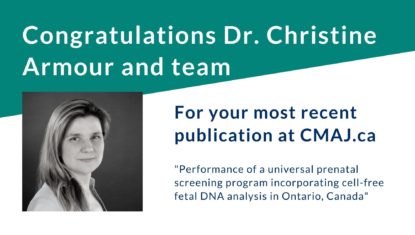BORN (Better Outcomes Registry & Network) is Ontario’s pregnancy, birth and childhood registry and network. Established in 2009 to collect and share critical data about each child born in the province, BORN Ontario manages an advanced database that provides reliable, comprehensive information on maternal and child care.
Because every pregnancy and birth in Ontario is thoroughly documented, and because the clinical data collected are complete, professionals in every discipline within the health sector gain vital knowledge they can apply to improve the system.
The result is change that contributes directly to the well being of mothers, with positive and lasting effects on the health of newborns, children and the citizens of Ontario.
BORN is funded by the Ontario Ministry of Health and Long Term Care, administered by the Children’s Hospital of Eastern Ontario and active in every region of the province. As a prescribed registry under Ontario’s Personal Health Information Protection Act, BORN safeguards data while making information available to facilitate and improve health care. BORN’s rigorous privacy policies are reviewed regularly by the Information and Privacy Commissioner of Ontario to ensure accordance with privacy legislation and data-system standards.
Related News
Research Projects
-
Association between prenatal air pollutant exposure and autism spectrum disorders in young children: A matched case-control study in Canada
03/08/2024
-
Associations of neighborhood greenspace, and active living environments with autism spectrum disorders: A matched case-control study in Ontario, Canada
01/07/2024
-
Cannabis use in pregnancy and maternal and infant outcomes: A Canadian cross-jurisdictional population-based cohort study
23/11/2023
The Government of Canada passed the Cannabis Act (Bill C-45) on October 17th, 2018, legalizing the possession, distribution, sale and production of cannabis in Canada [1]. Approximately 15% of Canadian women of childbearing age reported cannabis use in the year prior to legalization, a trend that is expected to increase with the changing legislation [2–4]. Cannabinoids readily cross the human placenta, potentially causing both immediate and delayed health effects [5]. It is hypothesized that prenatal exposure to cannabis produces similar outcomes to tobacco by reducing blood flow to the placenta [6]. Limited research has reported that prenatal cannabis exposure adversely impacts neurodevelopment in male fetuses but not female fetuses through growth restriction [7–13]. Evidence suggests potential sex differences in the affinity of cannabinoid receptor 1 in the brain, the main target of Δ9-Tetrahydrocannabinol [12].
-
Data Resource Profile: Better Outcomes Registry & Network (BORN) Ontario
01/11/2021
The Better Outcomes Registry & Network (BORN) Ontario collects pregnancy, birth and newborn information and outcomes data for nearly all births in Ontario, Canada. With nearly complete capture of the approximate 140 000 births each year in Ontario—∼40% of births in Canada—BORN Ontario is the largest perinatal registry in the country.
-
Obstetrical safety indicators for preventing hospital harms in low risk births
02/04/2020
This question is: According to the available literature, what are the obstetrical safety indicators related to processes of care for low risk births that aim to reduce preventable hospital harms?
-
A novel method for quantitation of acylglycines in human dried blood spots by UPLC-tandem mass spectrometry
01/04/2020
This method shows potential application as a second tier screen in order to reduce the false positive rate for a number of IEM targeted by newborn screening.
-
Association between interpregnancy interval and subsequent stillbirth in 58 low-income and middle-income countries: a retrospective analysis using Demographic and Health Surveys
01/01/2020
Although interpregnancy intervals of less than 12 months were associated with increased risk of stillbirth, these effects were attenuated when considering second and third intervals, suggesting the association in the first interval might not be causal.
-
Racial/ethnic variations in gestational weight gain: a population-based study in Ontario
09/08/2019
Inadequate and excessive gestational weight gain (GWG) have both been linked with a number of adverse maternal and neonatal outcomes, which in turn also vary by race/ethnicity (Headen et al. 2012).
-
Agreement Assessment of Key Maternal and Newborn Data Elements Between Birth Registry and Clinical Administrative Hospital Databases in Ontario, Canada
01/07/2019
We used provincial health card numbers to deterministically link live or stillbirth records and their corresponding mothers' records in the BORN database to the CIHI-DAD in the fiscal years 2012-2013 to 2014-2015.
-
Applying Data Preprocessing Methods to Predict Premature Birth
18/07/2018
Researchers
-
Kasim Abdulaziz
Investigator, CHEO Research Institute
-
Erika Bariciak
Investigator, CHEO Research Institute
-
Christina Cantin
Scientist CHEO, Research Institute
-
Pranesh Chakraborty
Investigator, CHEO Research Institute
-
Private: Aislinn Conway
Investigator, CHEO Research Institute
-
Daniel Corsi
Scientist, CHEO Research Institute
-
Dina El Demellawy
Investigator, CHEO Research Institute
-
Deshayne Fell
Affiliate Investigator, CHEO Research Institute
-
Jeff Gilchrist
Associate Scientist, CHEO Research Institute
-
Nathalie Lepage
Investigator, CHEO Research Institute
-
Grace (Qun) Miao
Investigator, CHEO Research Institute
-
Neal Sondheimer
Investigator, CHEO Research Institute
-
Ann Sprague
Investigator, CHEO Research Institute
-
Elisabeth Vesnaver
Investigator, CHEO Research Institute

















